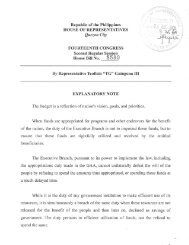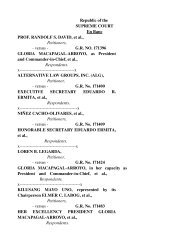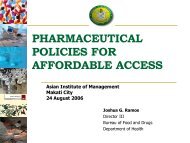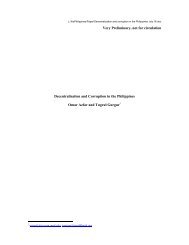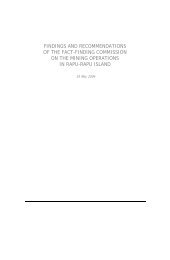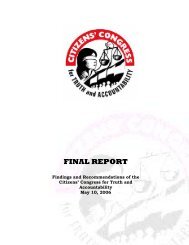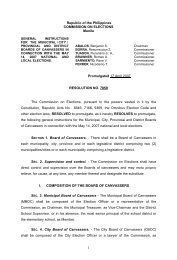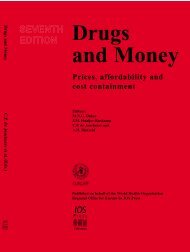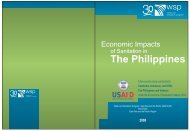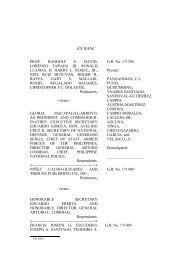The state of water resources in the Philippines - Greenpeace
The state of water resources in the Philippines - Greenpeace
The state of water resources in the Philippines - Greenpeace
You also want an ePaper? Increase the reach of your titles
YUMPU automatically turns print PDFs into web optimized ePapers that Google loves.
(g) Not more than 60 mg/L <strong>in</strong>crease (dry season)<br />
(h) If effluent is <strong>the</strong> sole source <strong>of</strong> supply for irrigation, <strong>the</strong> maximum limits are 1,500 mg/L and 1,000 mg/L,<br />
respectively, for old <strong>in</strong>dustries and new <strong>in</strong>dustries.<br />
(i) Not present <strong>in</strong> concentration to affect fish flavor or taste or ta<strong>in</strong>t<strong>in</strong>g.<br />
(j) If effluent is used to irrigate vegetable and fruit crops which may be eaten raw, Fecal Coliforms should be<br />
less than 500 MPN/100 mL<br />
Industry Classification Based on<br />
BOD <strong>of</strong> Raw Waste<strong>water</strong>s Produced<br />
1. Industries produc<strong>in</strong>g BOD with<strong>in</strong><br />
3,000 to 10,000 mg/L<br />
2. Industries produc<strong>in</strong>g BOD with<strong>in</strong><br />
10,000 to 30,000 mg/L<br />
Maximum Allowable Limits <strong>in</strong> mg/L, accord<strong>in</strong>g to<br />
Time Period and Receiv<strong>in</strong>g Body <strong>of</strong> Water<br />
Effectivity date - Dec. 31, 1991<br />
Inland Waters Coastal Waters<br />
(Class SC<br />
(Class C & D) & SD)<br />
650 or<br />
320 or<br />
90%<br />
95% removal removal<br />
1,000 or<br />
95% removal<br />
2,000 or<br />
90%<br />
removal<br />
3,000 or<br />
90%<br />
removal<br />
Jan. 1, 1992-Dec. 31,<br />
1994<br />
Inland Waters Coastal<br />
Waters<br />
(Class C (Class SC<br />
& D) & SD)<br />
200 or 320 or<br />
97% 95%<br />
removal removal<br />
600 or<br />
97%<br />
removal<br />
900 or<br />
97%<br />
removal<br />
1,000 or<br />
95%<br />
removal<br />
1,500 or<br />
95%<br />
removal<br />
3. Industries produc<strong>in</strong>g more than or 1,500 or<br />
30,000 mg/L<br />
95% removal<br />
Table 10. Interim effluent standards for BOD applicable to old or exist<strong>in</strong>g <strong>in</strong>dustries produc<strong>in</strong>g<br />
strong <strong>in</strong>dustrial wastes (1990 to1994)<br />
Industry Classification Based on BOD <strong>of</strong> Raw<br />
Waste<strong>water</strong><br />
Maximum Allowable Limits <strong>in</strong> mg/L<br />
Based on Receiv<strong>in</strong>g Body <strong>of</strong> Water<br />
Inland Waters Coastal Waters<br />
(Class C & D) (Class SC & SD)<br />
1. Industries produc<strong>in</strong>g with<strong>in</strong> 3,000 to 10,000 mg<br />
BOD/L 130 or 98% removal 200 or 97% removal<br />
2. Industries produc<strong>in</strong>g with<strong>in</strong> 10,000 to 30,000 mg<br />
BOD/L 200 or 99% removal 600 or 97% removal<br />
3. Industries produc<strong>in</strong>g more than 30,000 mg BOD/L 300 or 99% removal 900 or 97% removal<br />
Table 11. Effluent standards for new <strong>in</strong>dustries produc<strong>in</strong>g strong wastes (<strong>in</strong>clud<strong>in</strong>g old or<br />
exist<strong>in</strong>g <strong>in</strong>dustries produc<strong>in</strong>g strong waste whose waste<strong>water</strong> treatment plants are still to be<br />
constructed)<br />
A report by <strong>the</strong> United Nations Industrial Development Organizations (UNIDO)<br />
mentions that while <strong>the</strong>re are several standards already developed, <strong>the</strong> Philipp<strong>in</strong>e<br />
system <strong>of</strong> <strong>in</strong>dustrial effluent standards appears to be relatively <strong>in</strong>sensitive to<br />
actual ambient conditions and to different cost structures due to <strong>the</strong>ir use <strong>of</strong><br />
concentration-based standards.<br />
<strong>The</strong> report observes that this situation allows polluters to meet standards by<br />
dilution and encourage <strong>the</strong> over-extraction <strong>of</strong> ground <strong>water</strong> <strong>in</strong> heavily<br />
<strong>in</strong>dustrialized areas (UNIDO, 1999).<br />
In addition, <strong>the</strong>se standards do not adequately assess today's <strong>water</strong> quality<br />
especially with <strong>the</strong> proliferation <strong>of</strong> toxic chemicals used for and as a byproduct <strong>of</strong><br />
modern-day production processes and o<strong>the</strong>r economic activities. Beryllium,<br />
GREENPEACE | <strong>The</strong> <strong>state</strong> <strong>of</strong> <strong>water</strong> <strong>in</strong> <strong>the</strong> Philipp<strong>in</strong>es 38



